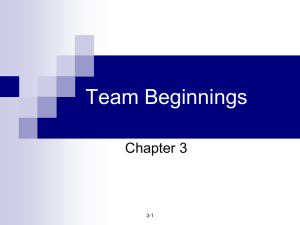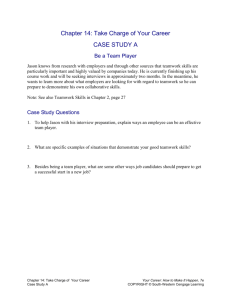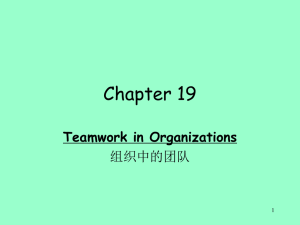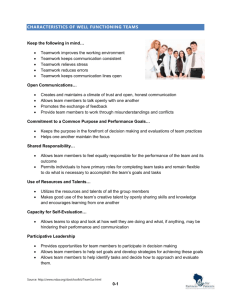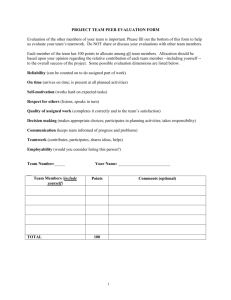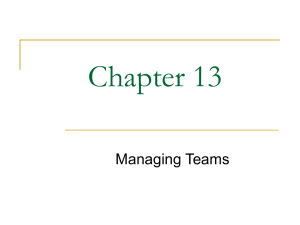Groups and Teams
advertisement
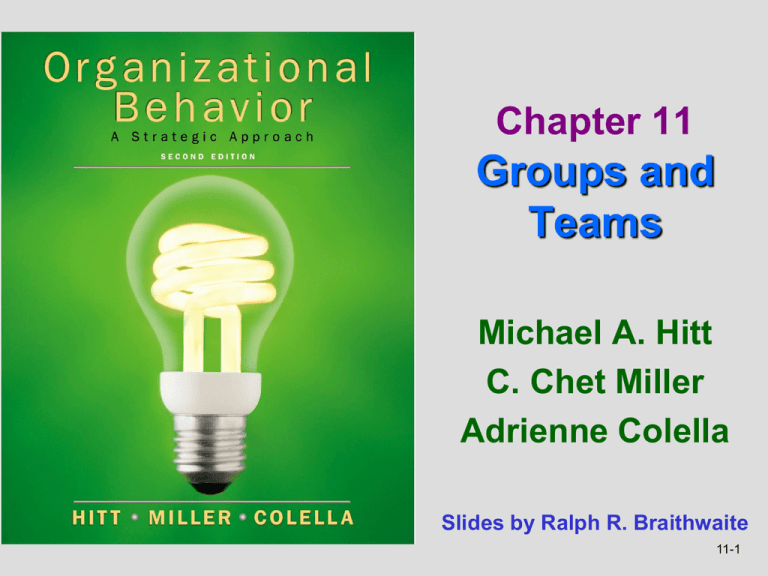
Chapter 11 Groups and Teams Michael A. Hitt C. Chet Miller Adrienne Colella Slides by Ralph R. Braithwaite 11-1 Teamwork at Starbucks Starbucks has partnered with a variety of organizations to help them sell coffee. How has this helped them? Several factors have contributed to their success – effective branding, superior product quality, product innovation, superior customer service, innovative human resources practices, and more. But some think their real key is teamwork of the people who work there. Agree or disagree? Why? They attribute the team success to hiring the right people, training them well, a generous benefits package, and extensive communication. Discuss. Exploring Behavior in Action 11-2 The Strategic Importance of Groups and Teams • Common way of doing work today • Teamwork is a major part of business education • Effective work teams have synergy – the total output of the team is greater than the sum of the individual contributions alone • High-performance work teams can achieve • extraordinary results To succeed, teams have to be: • effectively composed • structured • developed • managed • supported by management 11-3 Knowledge Objectives 1. Describe the nature of groups and teams and distinguish among different types of teams. 2. Explain the criteria used to evaluate team effectiveness. 3. Discuss how various aspects of team composition influence team effectiveness. 4. Understand how structural components of teams can influence performance. 5. Explain how various team processes influence team performance. 6. Describe how teams develop over time. 7. Know what organizations can do to encourage and support effective teamwork. 8. Understand the roles of a team leader. 11-4 Groups and Teams Defined Group Team Common Threads Two or more interdependent individuals who influence one another 11-5 Types of Groups and Teams Formal Groups Informal Groups Virtual Teams Identity Groups 11-6 Virtual Team Technologies • • • • • • • • • • • Audio teleconferencing Video communication systems Real-time electronic communication Different-time electronic communication Keypad voting systems Group project management software Wireless communication devices Instant messaging and texting Messaging boards Web conferencing Blogs and Wiki sites Adapted from Exhibit 11-1: Technology Commonly Used By Virtual Teams 11-7 Managing Virtual Teams Managerial Advice • • • • Develop a virtual team charter Provide reports on project progress Set up communication rules Humanize everyone on the team – share pictures and personal information Handle serious conflicts face-to-face • • Have as much face-to-face communication • as possible Reward positive team behavior and celebrate team success 11-8 Functional Teams Production Teams Service Teams Management Teams Project Teams Advisory Teams 11-9 Self-Managing Teams Have considerable autonomy and control over the work they do, and are responsible for completing a whole piece of work or an entire project. Benefits may include: • More worker satisfaction • Lower turnover and absenteeism • Increased productivity • Higher quality of work • More engaged in the work • Higher level of commitment to the team 11-10 Knowledge Criteria Affective Criteria Team Effectiveness Outcome Criteria Is the Team Needed? 11-11 Diagnostic Checklist • Does the project really require • • collective work? Jon Katzenbach Do team members lead various aspects of the project? Do people on the team hold one another accountable? 11-12 Factors Affecting Team Effectiveness Synergy • Greater goal commitment • Greater variety of skills and abilities • used for task achievement Greater sharing of knowledge • Time and energy members spend maintaining the team Process Loss • Managing, coordinating, and developing effective communication within the team 11-13 Team Composition Identifies who are members of the team and what human resources (skills, abilities, and knowledge) they bring to the team. Three common assumptions which can lead to mistakes: • Assume that people who are similar to each other will • • work better together – create homogeneous teams Assume everyone knows how or is suited to work in a team Assume that a larger team is always better 11-14 Diversity Both positive, negative, and neutral effects for demographic diversity. Also need to consider values of team members. Other factors to consider: • • • • Type of task Outcome Time Type of diversity 11-15 Personality The personality traits that have important effects on team performance include: • • • • • Agreeableness Emotional stability Individual conscientiousness Team-level extraversion Openness to experience 11-16 Team Orientation The extent to which an individual works well with others, wants to contribute to team performance, and enjoys being on a team. Three companies that rely on teamwork mentioned in the chapter cases are: 11-17 Team Size and Performance No one best size team for all situations. Team Performance High Task Environment Low 2 5 8 11 13 . . . Number of Team Members Adapted from Exhibit 11-2: The Relationship Between Team Size and Team Performance 11-18 Team Structure The usual means of coordinating formal team efforts. Leaders are appointed, work rules and procedures are detailed, and job descriptions specify individual task responsibilities. 11-19 Designing for Teamwork What are your thoughts about the suggestions for arranging an office – delineate boundaries; associates should be able to see each other; create a quiet, collaborative workspace; provide furniture that can be rearranged; and ways to signal others that they are unavailable and should not be disturbed? Teamwork is more that furniture – it depends on the culture, management system and reward system. Agree or disagree? Why? D.J. De Pree Experiencing Strategic OB 11-20 Team Roles Task Roles • • • • • • • • • • • Socioemotional Roles Roles – expectations shared by • Encourager • Standard Setter Initiator/Contributor group members about who is to Harmonizer • Observer Informationperform Seeker what•types of tasks and • Compromiser • Follower conditions. Information Giverunder what • Gatekeeper Elaborator Opinion Giver Coordinator Individual Roles Orienter Evaluator/Critic Energizer Procedural Technician • Aggressor • Blocker • Dominator Recorder Adapted from Exhibit 11-3: Roles in Teams • Evader • Help Seeker • Recognition Seeker 11-21 Norms Rules or standards that regulate the team’s behavior. Norms tend to emerge naturally and are part of the team’s mental model. Sometimes norms are written down. What types of norms exist in the classroom? How do norms help a team? How can norms hurt a team? 11-22 Task Structure Divisible Tasks Unitary Tasks Maximization Tasks Optimization Tasks Additive Tasks Compensatory Tasks Disjunctive Tasks Conjunctive Tasks 11-23 Team Processes Interpersonal Cohesion Task Personal Conflict Social Facilitation Social Loafing Substantive Procedural Communication 11-24 Avoiding Social Loafing Make Individual Contributions Visible • Smaller rather than larger teams • Evaluation system in which everyone’s individual • contributions are noted Someone to monitor and oversee everyone’s contributions Foster Team Cohesiveness • Provide team-level rewards • Teamwork training • Select “team players” to be on the team 11-25 Backup at Cirque Du Soleil Cirque Du Soleil has an interesting approach to teamwork. How well would their approach work in other types of organizations? Explain. How well would their approach work in your organization? Explain. Why is having a backup plan important today? What are your thoughts on the recent research related to providing backup? Experiencing Strategic OB 11-26 Stages of Team Development Forming Storming Norming Performing Adjourning Adapted from Exhibit 11-4: Models of Team Development 11-27 Punctuated Equilibrium Model First Stage: • Norming Activities • Focus on Socioemotional Roles Second Stage: • Performing Activities • Focus on Task Roles Task deadline approaches or half-way mark in teams’ tenure Adapted from Exhibit 11-4: Models of Team Development 11-28 Managing for Effective Teams Top Management Support • Explicit vision and • • • • strategic plan Use results-oriented measurement of outcomes Actively include associates at all levels in decision-making process Make explicit decisions about using teams Actively manage and review support systems for teams Support Systems • Technology • Information systems • Selection of team • • • members Training Rewards Leadership 11-29 The Strategic Lens 1. Think of some teams of which you have been a member. How successful were they? To what do you attribute your teams’ success or lack thereof? 2. Why do organizations use teams to accomplish the work that needs to be done? What value do teams provide? 3. Someday you will be a leader of a team. What processes will you use to select team members? What specific actions will you take to manage the team to ensure high team productivity? 11-30 Questions 11-31
